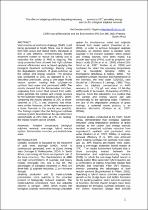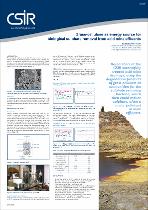 ResearchSpace
ResearchSpace
Effect of adapting cellulose degrading microorganisms to 25°C providing energy sources for biological sulphate removal
JavaScript is disabled for your browser. Some features of this site may not work without it.
- ResearchSpace
- →
- Research Publications/Outputs
- →
- Conference Publications
- →
- View Item
| dc.contributor.author |
Greben, HA

|
|
| dc.contributor.author |
Sigama, NJ

|
|
| dc.date.accessioned | 2008-11-14T09:05:00Z | |
| dc.date.available | 2008-11-14T09:05:00Z | |
| dc.date.issued | 2008-11 | |
| dc.identifier.citation | Greben, HA and Sigama, NJ. 2008. Effect of adapting cellulose degrading microorganisms to 25°C providing energy sources for biological sulphate removal. Science real and relevant: 2nd CSIR Biennial Conference, CSIR International Convention Centre Pretoria, 17 & 18 November 2008, pp 8 | en |
| dc.identifier.uri | http://hdl.handle.net/10204/2573 | |
| dc.description | Science real and relevant: 2nd CSIR Biennial Conference, CSIR International Convention Centre Pretoria, 17 & 18 November 2008 | en |
| dc.description.abstract | Vast volumes of acid mine drainage (AMD) is still being generated in South Africa, due to decant from both active and closed mines. Research to find a cost effective, environmentally friendly treatment system to reduce the salinity and to neutralise the acidity of AMD is ongoing. The study presented here showed that high sulphate removal efficiencies were achieved applying the biological treatment technology, thereby using the degradation products of grass-cellulose as the carbon and energy sources. The process was conducted at 25°C, as opposed to 37°C described previously; using a one-stage hybrid reactor system, treating both sulphate-rich synthetic feed water and pre-treated AMD. The results showed that the fermentation microbes, originating from rumen fluid derived from cattle, could generate the carbon and energy sources for the sulphate reducing bacteria at 25°C. When comparing the results obtained at 25°C to those obtained at 37°C, it was observed that these were similar. However, at the higher temperature a faster flow-rate to the reactor was possible. The findings implied that the biological sulphate removal system described can be operated more economically at 25°C than at 37°C, as heating the reactor system can be omitted | en |
| dc.language.iso | en | en |
| dc.subject | Ambient temperature | en |
| dc.subject | Biological sulphate removal | en |
| dc.subject | One-stage hybrid reactor system | en |
| dc.subject | Fermentation microbes | en |
| dc.subject | Pre-treated mine water | en |
| dc.title | Effect of adapting cellulose degrading microorganisms to 25°C providing energy sources for biological sulphate removal | en |
| dc.type | Conference Presentation | en |
| dc.identifier.apacitation | Greben, H., & Sigama, N. (2008). Effect of adapting cellulose degrading microorganisms to 25°C providing energy sources for biological sulphate removal. http://hdl.handle.net/10204/2573 | en_ZA |
| dc.identifier.chicagocitation | Greben, HA, and NJ Sigama. "Effect of adapting cellulose degrading microorganisms to 25°C providing energy sources for biological sulphate removal." (2008): http://hdl.handle.net/10204/2573 | en_ZA |
| dc.identifier.vancouvercitation | Greben H, Sigama N, Effect of adapting cellulose degrading microorganisms to 25°C providing energy sources for biological sulphate removal; 2008. http://hdl.handle.net/10204/2573 . | en_ZA |
| dc.identifier.ris | TY - Conference Presentation AU - Greben, HA AU - Sigama, NJ AB - Vast volumes of acid mine drainage (AMD) is still being generated in South Africa, due to decant from both active and closed mines. Research to find a cost effective, environmentally friendly treatment system to reduce the salinity and to neutralise the acidity of AMD is ongoing. The study presented here showed that high sulphate removal efficiencies were achieved applying the biological treatment technology, thereby using the degradation products of grass-cellulose as the carbon and energy sources. The process was conducted at 25°C, as opposed to 37°C described previously; using a one-stage hybrid reactor system, treating both sulphate-rich synthetic feed water and pre-treated AMD. The results showed that the fermentation microbes, originating from rumen fluid derived from cattle, could generate the carbon and energy sources for the sulphate reducing bacteria at 25°C. When comparing the results obtained at 25°C to those obtained at 37°C, it was observed that these were similar. However, at the higher temperature a faster flow-rate to the reactor was possible. The findings implied that the biological sulphate removal system described can be operated more economically at 25°C than at 37°C, as heating the reactor system can be omitted DA - 2008-11 DB - ResearchSpace DP - CSIR KW - Ambient temperature KW - Biological sulphate removal KW - One-stage hybrid reactor system KW - Fermentation microbes KW - Pre-treated mine water LK - https://researchspace.csir.co.za PY - 2008 T1 - Effect of adapting cellulose degrading microorganisms to 25°C providing energy sources for biological sulphate removal TI - Effect of adapting cellulose degrading microorganisms to 25°C providing energy sources for biological sulphate removal UR - http://hdl.handle.net/10204/2573 ER - | en_ZA |






